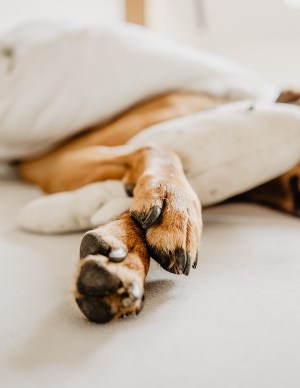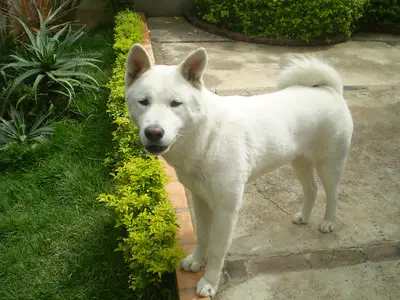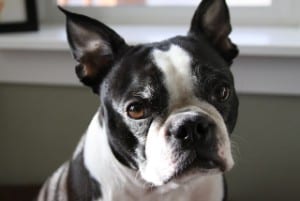
Many new pet parents are surprised to discover their puppy has black nails and wonder if this is normal.
Yes, as opposed to cats who only have clear whitish nails, dogs can also have black nails.
Some do, indeed, have white nails (mostly dogs with a white coat) and you can also see dogs who have both white and black nails, and it’s perfectly normal.
In this article we will examine why dogs have black nails and some of the breeds for which this feature is prevalent.
What dog breeds have black nails?
It’s not so much a question of breed, but rather of the skin and fur color of the dog. Black-coated dogs will most likely have black nails.
However, this trait is also common in dogs with brown fur or dogs with a multicoloured coat. If the fur on the dog’s legs is dark, the nails will also be dark.
Some believe that black nails in a dog are part of a camouflage mechanism. If the dog’s fur is dark, the equally black nails won’t stand out.
Trimming a dog’s black nails is a bit tricky as you cannot easily tell where the quick of the nail is and there’s the risk of cutting it.
Let’s examine some black-coated dog breeds whose members will almost certainly have black nails.
9 Dog Breeds with Black Nails
[1] Black Labrador Retriever
Maybe you’ve seen chocolate or yellow Labrador Retrievers, but originally this breed of dogs had a full black coat.
These dogs were first bred as gun dogs, or hunting companions trained to retrieve the prey. This requires a certain degree of intelligence, so most Labs are smart, energetic and friendly by nature.
They love to be around humans, including children, which makes them wonderful pets. No wonder this breed ranks first when it comes to the most popular pets.
The average Black Labrador Retriever weighs around 80 lbs and stands 24.5 inches tall. Since they have straight short hair, Labs don’t require much grooming, except for the occasional bath and a good brushing every week.
These dogs need regular exercise and, if you cannot take them hunting, you can satisfy their natural retrieving instinct with a game of fetch.
[2] Pug
Most pugs have a shiny black coat, although there are some with fawn fur and a black face and muzzle.
This squat and muscular little toy dog weighs 14-18 pounds on average and stands 10-13 inches tall.
The smooth short coat doesn’t require much maintenance, but it is a breed that tends to shed a lot so pugs need to be brushed every week with medium brush or a rubber grooming mitt. Their black nails need to be trimmed on a regular basis to prevent discomfort.
Pugs are very playful and love games, when they’re not napping on the sofa, that is. They require only moderate exercise, but they need almost constant human companionship. Very sociable and affectionate!
[3] Newfoundland
Newfoundland dogs are commonly referred to as the ‘gentle giant’.
They’re massive dogs weighing between 100 and 150 pounds, but they are very affectionate and lovable.
Newfies have a thick double coat which requires brushing several times a week, and you’ll want to take good care of their fur as they also shed a lot.
Newfoundlands belong to the working group as they were originally bred as rescue dogs for drowning sailors in case of a shipwreck off the Newfoundland coast.
They still love to swim, but they don’t care much for physical exercise. If their favorite humans are at home,
Newfoundlands love to chill with them and doze off in a corner.
[4] Doberman
A solid black Doberman is a majestic animal with a sleek and strong, muscular body. This medium-large dog weighs 90 lbs on average and reaches up to 27-28 inches at maturity.
Since they have a short coat, you don’t need to brush them more than once a week, as for giving them a bath, only when they roll in the mud or develop significant body odor.
Dobermans make excellent guard dogs, and their perceived aggressiveness can be easily kept under control with good obedience training.
And they are very devoted to their owners. They are very energetic dogs and will need a lot of physical exercise, not just a walk around the block.
[5] Puli
This breed is known as the acrobat of the dog’s world, as these dogs are very agile and energetic.
Nothing funnier than to watch a Puli run with his trademark dreadlocks flying in the wind. The thick cords in their fur require professional grooming, but, on the other hand, there’s very little shedding.
Some owners prefer to keep the dog’s coat trimmed, but what is a Puli without dreadlocks? Not only do they have black nails, but also black pads and noses. Even the inside of their mouth is black.
They reach up to 16-17 inches at the shoulder, and they are very energetic. Such dogs are perfect for hiking or as jogging companions. Pulis have a strong herding instinct and are very protective of their family, including the little ones.
[6] Black Russian Terrier
This type of dog appeared in 20th century Russia and there were several breeds involved in its creation.
Among them, Great Dane, Saint Bernard and Rottweiler, from whom it inherited the black coat and nails.
Black Russian Terriers (BRT) are large dogs, weighing 110-130 lbs and reaching up to 30 inches in height.
A BRT has a double coat with a soft undercoat and a coarse slightly waved outer coat. Such a dog doesn’t shed much, but its fur requires weekly brushing to prevent matting.
They need a job to do or, fail that, a lot of exercise. Lack of exercise makes BRT hyper-active and they tend to become destructive when bored.
[7] Rottweiler
Rottweilers are among the most popular dog breeds, mostly because they’re large enough to make great bodyguards, but they are also surprisingly playful and affectionate with their owners.
They have a short and coarse black and tan coat which requires regular brushing, at least once a week. Also, their nails should be trimmed once a week. It is essential to start doing this when they are young and manageable so they get used to it. Otherwise, you’ll have a hard time convincing a 120lbs dog to sit still for a pedicure.
[8] Dachshund
Dogs of this breed have a black and tan coat, which can be either smooth or wired, the latter requiring some extra grooming.
While miniature Dachshunds only weigh 11 lbs, the standard type weighs between 16 and 32 lbs. They’re very popular as pets because they look so cute, but also because they have a friendly disposition.
They tend to be a little stubborn though, even mischievous sometimes, so good early training is a must.
Since this dog was bred to hunt badgers, expect some furious digging in your garden.
[9] Chihuahua
This little bundle of energy has a black and tan coat, and black nails. This miniature dog barely weighs 4-6 lbs and doesn’t grow more than 6 – 10 in. Being so little, it’s easy to take them with you anywhere, which makes them an excellent choice as pets.
Chihuahuas can be either smooth-haired or long-haired, but their coat is typically easy to care for.
Very smart and alert, Chihuahuas love to play watch dogs although their diminutive size hardly recommends them for that. At least, they’re good for raising the alarm in case of an intruder. They will bark energetically with all the confidence of a much larger dog. They are very energetic and love to play, but don’t let small children near them. Chihuahuas are so small and fragile they can easily get hurt.
What determines the colour of a dog’s nails?
Nails are made of alpha-keratin, a protein also found in hairs and the top layer of the skin, the epidermis. The color of hair or nails is determined by the level of pigment, or melanin, produced by specialized cells called melanocytes. High concentrations of melanin determine the dark color of the skin and hair.
It is only natural that if the surrounding fur and skin are of a dark color, the nails will also be dark, as the level of pigment in the tissue is roughly the same.
It is also a question of genetics. If both parents of a puppy have black nails, so will their offspring.
Why do some dogs have some black and some white nails?
Dogs with black and white nails look a bit odd, but such a pattern is perfectly normal for dogs with multicolored coats. When a dog has a largely white coat with big patches of black and brown, the levels of pigment in their hairs varies wildly. The same goes for the nails. When a dog has dark fur on the legs, the nails are usually black. However, when the dog’s fur is streaked with various colors some of the nails might be black, while others might be black.
Also, it’s not unusual for the color of the nails to change over time.
Why do some dog’s nails turn black?
If you notice your dog’s nails are slowly turning black, but otherwise you see no signs of a health problem, it might be because of the natural variance in pigment levels. Sometimes, the nails tend to turn black as the dog grows older.
On the other hand, this might be a symptom of some disease. First of all, you need to examine the dog’s paws carefully, especially the pads. If your dog licks his paws excessively or chews at his feet, he might have a yeast infection, which also causes the nails to become dark.
Hypothyroidism can also cause hair, skin and nails color changes. Hypothyroidism means the dog has an underactive thyroid, a condition which can lead to weight gain, obesity. Your dog will require medication to keep this condition under control.
Cushing’s disease is also a hormone imbalance and it appears when the dog’s body produces too much cortisol, aka the stress hormone. The main symptoms are drinking a lot of water and the need to pee more, tiredness and panting. A dog with Cushing’s disease tends to have thinning hair and is prone to skin infections. Nail color changes are also frequent with this disease.
Closing Thoughts
Dogs with a black coat tend to have black nails as well. The color of a dog’s nails is dictated by the levels of pigmentation, or melanin, present in his hair and skin. Dogs with a coat in two or more different colors will have black nails if the hairs on the feet are also of a dark color. When the fur on the legs is in different colors the dog might have some of the nails white and some black.
The color of a dog’s nails can change- mirroring changes in pigmentation levels. However, if your dog seems unwell you should see a vet as the nails changing color might be a symptom of some disease.






